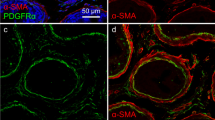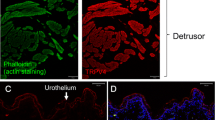Abstract
The vas deferens forms part of the male reproductive tract and extends from the cauda epididymis to the prostate. Using the patch clamp technique, we have identified a Ca2+-activated, voltage-dependent, maxi K+ channel on the apical membrane of epithelial cells cultured from human fetal vas deferens. The channel had a conductance of ∼250 pS in symmetrical 140 mm K+ solutions, and was highly selective for K+ over Na+. Channel activity was increased by depolarization and by an elevation of bath (cytoplasmic) Ca2+ concentration, and reduced by cytoplasmic Ba2+ (5 mm) but not by cytoplasmic TEA (10 mm). Channel activity was also dependent on the cation bathing the cytoplasmic face of the membrane, being higher in a Na+-rich compared to a K+-rich solution. We estimated that up to 600 maxi K+ channels were present on the apical membrane of a vas cell, and that their density was 1–2 per μ2 of membrane. Activity of the channel was low on intact cells, suggesting that it does not contribute to a resting K+ conductance. However, fluid in the lumen of the human vas deferens has a high K+ concentration and we speculate that the maxi K+ channel could play a role in transepithelial K+ secretion.
Similar content being viewed by others
References
Barrett, J.N., Magleby, K.L., Pallotta, B.S. 1982. Properties of single calcium-activated potassium channels in cultured rat muscle. J. Physiol. London 331:211–230
Brown, P.D., Loo, D.D.F., Wright, E.M. 1988. Ca2+-activated K+ channels in the apical membrane of Necturus choroid plexus. J. Membrane Biol. 105:207–219
Christensen, O., Zeuthen, T. 1987. Maxi K+ channels in leaky epithelia are regulated by intracellular Ca2+, pH and membrane potential. Pfluegers Arch. 408:249–259
Colquhoun, D., Hawkes, H.G. 1981. On the stochastic properties of single ion channels. Proc. R. Soc. London B 211:205–235
Cook, D.I., Huang, S.J., Wilson, S.M., Wong, P.Y.D., Young, J.A. 1989. Ion channels in the apical plasma membrane of the rat cauda epididymides. J. Physiol. 423:57P
Cook, D.I., Young, J.A. 1989. Effect of K+ channels in the apical plasma membrane on epithelial secretion based on secondary active Cl− transport. J. Membrane Biol. 110:139–146
Findlay, I. 1984. A patch-clamp study of potassium channels and whole-cell currents in acinar cells of the mouse lacrimal gland. J. Physiol 350:179–195
Findlay, L, Dunne, M.J., Petersen, O.H. 1985. High-conductance K+ channel in pancreatic islet cells can be activated and inactivated by internal calcium. J. Membrane Biol. 83:169–175
Fu, W.O., Huang, S.J., Wilson, S.M., Wong, P.Y.D. 1990. Adrenaline stimulates K+ (86RB+) efflux across the apical and basolateral membranes of monolayer cultures of the rat epididymis. J. Physiol. 423:50P
Gitter, A.H., Beyenbach, K.W., Christine, C.W., Gross, P., Minuth, W.W., Frömter, E. 1987. High-conductance K+ channel in apical membranes of principal cells cultured from rabbit renal cortical collecting duct anlagen. Pfluegers Arch. 408:282–290
Gray, M.A., Greenwell, J.R., Argent, B.E. 1988. Secretin-regulated chloride channel on the apical plasma membrane of pancreatic duct cells. J. Membrane Biol. 105:131–142
Gray, M.A., Greenwell, J.R., Garton, A.J., Argent, B.E. 1990. Regulation of maxi-K+ channels on pancreatic duct cells by cyclic AMP-dependent phosphorylation. J. Membrane Biol. 115:203–215
Greger, R., Schlatter, E., Wang, F., Forrest, J.N. 1984. Mechanism of NaCl secretion in the rectal gland of spiny dogfish (Squalus acanthias). III. Effect of stimulation of secretion by cyclic AMP. Pfluegers Arch. 402:376–384
Hamill, O.P., Marty, A., Neher, E., Sakmann, B., Sigworth, F.J. 1981. Improved patch-clamp techniques for high-resolution current recording from cells and cell-free membrane patches. Pfluegers Arch. 391:85–100
Harris, A., Coleman, L. 1989. Ductal epithelial cells cultured from human foetal epididymis and vas deferens: relevance to sterility in cystic fibrosis. J. Cell Sci. 92:687–690
Hinton, B.T., Pryor, J.P., Hirsh, A.V., Setchell, B.P. 1981. The concentration of some inorganic ions and organic compounds in the luminal fluid of the human ductus deferens. Int. J. Androl. 4:457–461
Hinton, B.T., Turner, T.T. 1988. Is the epididymis a kidney analogue? NIPS 3:28–31
Huang, S.J., Cook, D.I., Jones, A.O., Wong, P.Y.D., Young, J.A. 1990. The Ca2+- and voltage-sensitive potassium channels in the rat epididymis. In: Exocrine Secretion II. P.Y.D. Wong and J.A. Young, editors. pp. 65–68
Huang, S.J., Fu, W.O., Chung, Y.W., Zhou, T.S., Wong, P.Y.D. 1993. Properties of cAMP-dependent and Ca2+-dependent whole81 cell Cl− conductances in rat epididymal cells. Am. J. Physiol. 264: C794-C802
Huang, S.J., Leung, A.Y.H., Fu, W.O., Chung, Y.W., Zhou, T.S., Chan, P.S.F., Wong, P.Y.D. 1992. Electrophysiological studies of anion secretion in cultured human epididymal cells. J. Physiol. 455:455–469
Hunter, M., Lopes, A.G., Boulpaep, E., Giebisch, G. 1986. Regulation of single potassium ion channels from apical membrane of rabbit collecting tubule. Am. J. Physiol. 251:F725-F733
Kawahara, K., Hunter, M., Giebisch, G. 1990. Calcium-activated potassium channels in the luminal membrane of Amphiuma diluting segment: voltage-dependent block by intracellular Na+ upon depolarisation. Pfluegers Arch. 416:422–427
Latorre, R., Miller, C. 1983. Conduction and selectivity in potassium channels. J. Membrane Biol. 71:11–30
Latorre, R., Vergara, C., Hidalgo, C. 1982. Reconstitution in planar lipid bilayers of Ca2+-dependent K+ channel from transverse tubule membranes isolated from rabbit skeletal muscle. Proc. Natl. Acad. Sci. USA 79:805–809
Leung, A.Y.H., Wong, P.Y.D. 1992. Studies of transepithelial Cl− transport in cultured cauda epididymal cells of rats by the shortcircuit current method. J. Physiol. London 457:391–406
Levine, N., Marsh, D.J. 1971. Micropuncture studies of the electrochemical aspects of fluid and electrolyte transport in individual seminiferous tubules, the epididymis and the vas deferens in rats. J. Physiol. London 213:557–570
Ling, B.N., Hinton, C.F., Eaton, D.C. 1991. Potassium permeable channels in primary cultures of rabbit cortical collecting tubule Kidney Int. 40:441–452
Marty, A., Tan, Y.P., Trautmann, A. 1984. Three types of calcium-dependent channel in rat lacrimal glands. J. Physiol. 357:293–325
Maruyama, Y., Petersen, O.K., Flanagan, P., Pearson, G.T. 1983. Quantification of Ca2+-activated K+ channels under hormonal control in pig pancreas acinar cells. Nature 305:228–232
Maruyama, Y., Gallacher, D.V., Petersen, O.H. 1983. Voltage and Ca2+-activated K+ channel in baso-lateral acinar cell membranes of mammalian salivary glands. Nature 302:827–829
Mathews, C.J., Sohma, Y., Harris, A., Chambers, J.A., Argent, B.E. 1992. Maxi-K+ channels on epithelial cells cultured from human fetal vas deferens. J. Physiol. London 452:344P
Morris, A.P., Gallacher, D.V., Lee, J.A.C. 1986. A large conductance, voltage- and calcium-activated K+ channel in the basolateral membrane of rat enterocytes. FEBS Lett. 206:87–92
Plant, S., Gray, M.A., Argent, B.E. 1992. K+ channels on rat pancreatic duct cells in vitro. J. Physiol. 452:360P
Pollard, C.E., Harris, A., Coleman, L., Argent, B.E. 1991. Chloride channels on epithelial cells cultured from human fetal epididymis. J. Membrane. Biol. 124:275–284
Silva, P., Stoff, J., Field, M., Fine, L., Forrest, J.N., Epstein, F.H. 1977. Mechanism of active chloride secretion by shark rectal gland: role of Na-K-ATPase in chloride transport. Am. J. Physiol. 233:F298-F306
Suzuki, K., Petersen, O.H. 1988. Patch-clamp study of singlechannel and whole-cell K+ currents in guinea pig pancreatic acinar cells. Am. J. Physiol. 255:G275-G285
Tan, Y.P., Marty, A., Trautmann, A. 1992. High density of Ca2+-dependent K+ and Cl− channels on the luminal membrane of lacrimal acinar cells. Proc. Natl. Acad. Sci. USA 89:11229–11233
Turner, T.T., Hartmann, P.K., Howards, S.S. 1977. In vivo sodium, potassium, and sperm concentrations in the rat epididymis. Fertil. Steril. 28:191–194
Wegman, E.A., Ishikawa, T., Young, J.A., Cook, D.I. 1992. Cation channels in basolateral membranes of sheep parotid secretory cells. Am. J. Physiol. 263:G786-G794
Wong, P.Y.D. 1988. Inhibition by chloride channel blockers of anion secretion in cultured epididymal epithelium and intact epididymis of rats. J. Physiol. 94:155–163
Wong, P.Y.D. 1989. Potassium channel blockers inhibit anion secretion in cultured rat epididymal epithelium. Jpn. J. Physiol. 39:595–607
Wong, P.Y.D. 1990. Electrolyte and fluid transport in the epididymis. In: Epithelial Secretion of Water and Electrolytes. P.Y.D. Wong and J.A. Young, editors. pp. 333–347. Springer Verlag, Heidelberg, Berlin
Wong, P.Y.D., Lee, W.M. 1983. Potassium movement during sodium-induced motility initiation in the rat cauda epididymal spermatozoa. Biol. Reprod. 28:206–212
Wong, P.Y.D., Yeung, C.H. 1978. Absorptive and secretory functions of the perfused rat cauda epididymidis. J. Physiol. 275:13–26
Author information
Authors and Affiliations
Additional information
Funded by grants from the Cystic Fibrosis Trust and the Medical Research Council (UK). We thank Mr. David Stephenson for excellent technical assistance.
Rights and permissions
About this article
Cite this article
Sohma, Y., Harris, A., Wardle, C.J.C. et al. Maxi K+ channels on human vas deferens epithelial cells. J. Membarin Biol. 141, 69–82 (1994). https://doi.org/10.1007/BF00232875
Received:
Revised:
Issue Date:
DOI: https://doi.org/10.1007/BF00232875




